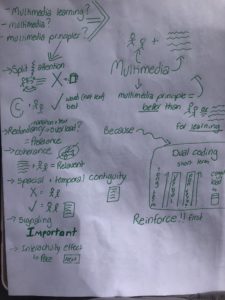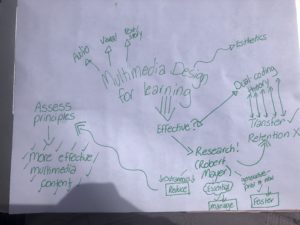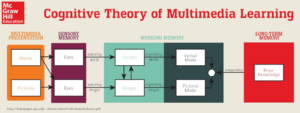I have learned a lot in the short amount of time that I have been exposed to and actively exploring multimedia and interactive learning. I was quite nervous initially to begin to look at some of these ideas due to my lack of prior knowledge on technology. However, something that I found to be very interesting is how closely linked all the principles discussed in regards to multimedia learning to the ways we have been learning to teach throughout the duration of our education degrees. This week I have come to see that because the principles are so closely related, using technology is not as foreign and scary of a concept for me to engage with anymore.
One principle, the collaboration principle, stating “People can learn better with collaborative online learning activities” (Mayer, 2014) is one principle that I strongly agree with. I have always believed from personal experiences that I learn better when I have others to share ideas and build on each other’s ideas with. Previously, I have thought of activities centered around technology to be individual based. That is not the case at all, and I am eager to learn more about ways to incorporate collaboration into multimedia and interactive learning throughout my practicum and other future teaching I engage in.
The self-explanation principle and the feedback principle are two more ideas that I was particular drawn to. The self-explanation principle states that “People learn better when they are encouraged to generate self-explanations during learning” (Mayer, 2014), whereas the feedback principle states that “People learn better from multimedia lessons when they receive explanative feedback on their performance” (Mayer, 2014). I found it interesting to see that a balance of the two needed to promote the most effective learning possible. This reminded me of my past playing and coaching sports. I agree that in situations where you are learning something new, it is of equal importance to gain feedback from others to identify areas where improvements can be made and to think individually and attempt new things independently in order to make progress. I believe the balance could be different for different individuals, so as a teacher identifying the students’ needs is something that may have to be learned.
These principles of multimedia learning, as well as others, are important not only in teaching multimedia and while incorporating technology, but in every area of teaching and learning. These principles are something that I will continuously look back on to ensure best practice while learning how to teach using multimedia.


References
Mayer, R. E. (2014). The Cambridge Handbook of Multimedia Learning. Retrieved from https://doi-org.ezproxy.library.uvic.ca/10.1017/CBO9781139547369

